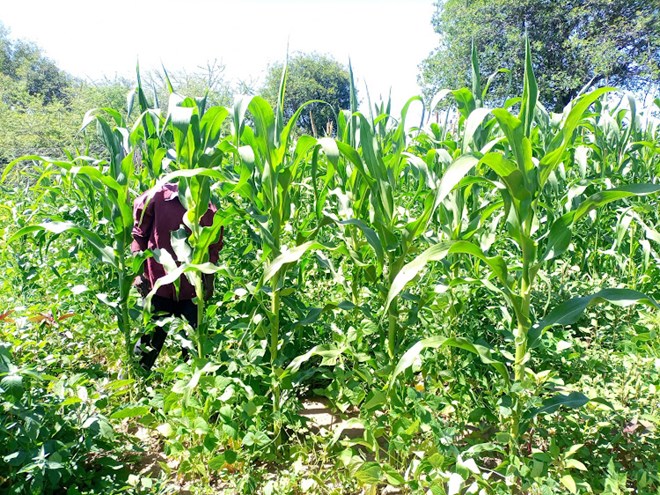
by JOHN MUCHANGI
Wednesday June 28, 2023

Farmer Mulyungi Musyomi at a maize farm in Mwingi North, Kitui county, two weeks ago. Many farmers expect a good harvest
Image: MUSEMBI NZENGU
The months of July, August and September will be dry and cool across the country, according to a new three-month forecast.
This weather is gloomy for farmers who planted maize late because their crops still needed some rain to mature.
The Dagoretti Corner-based IGAD Climate Prediction and Applications Centre (Icpac) said only the Coast can expect more rains in the next three months.
Temperatures will be higher than average in these three months across the country.
“Drier than normal conditions expected over Western Kenya,” Icpac said in a statement.
“Eastern and southern Kenya will be generally dry during this season.”
Western Kenya will remain mostly dry, and any rainfall that comes will be below average, Icpac said.
Despite the low rainfall, meteorologists still confirmed an El Niño is developing.
This weather pattern, caused by the warming of the Pacific Ocean, is associated with heavy rains in Kenya.
Kenya Meteorological Department head Dr David Gikungu, however, said this was not automatic and any heavy rains would probably come in October.
Gikungu said it is important to note that El Niño itself is not rain, but rather an effect that can impact weather patterns and lead to heavier-than-normal rainfall in East Africa.
“While heavy rains are commonly experienced during El Niño events, it is also notable that these effects are typically most significant during the October-January months and not in June, July and August,” Gikungu said.
“It should also be understood that El Niño is not necessarily a direct cause of heavy rainfall. While it can impact weather patterns and result in heavier-than-normal rainfall, the effects of El Niño can vary significantly between events.”
He said in 1987, for instance, October-December season was an El Niño event that did not result in heavy rainfall over the country.
Additionally, in 2015, the El Niño index was higher than that of 1997, but the country did not experience as much rainfall as it did in 1997.
Yale Climate Connections, a US-based climate change analysis service, also noted the tropical Pacific is especially warm this month on its far eastern end, off the coast of South America.
Should this continue, it will point toward a “classic” El Niño event (as opposed to one where the peak warming is thousands of miles west). Classic events are more likely to produce the classic El Niño effects on weather and climate, which point to a mild, wet winter across much of the southern US.
Last week, Icpac also released a report showing about 5.4 million Kenyans are already facing a food crisis.
This crisis was blamed on the effects of drought, record-high prices and lack of money.
The report projected millions of people would need relief food regardless of the harvest from the current season or El niño rains in Kenya, Somalia, South Sudan, Sudan and Uganda throughout the year.
“Since 2021, Kenya and Somalia saw the biggest increases in the numbers of people facing high levels of acute food insecurity,” said Icpac in its Igad Regional Focus of the Global Report on Food Crises 2023 report.
In Kenya, 5.4 million people were projected to be in hunger crisis or emergency situation in March–June 2023.
This is the highest in the history of this regional focus, due primarily to the continued impacts of the unprecedented drought and high food prices.
The report used the Integrated Food Security Phase Classification scale for acute food insecurity.
The five-phase scale provides common standards for classifying the severity of acute food insecurity and global hunger, with Kenya placed at Level 3 or higher.
The report predicts up to 30 million people will require humanitarian food assistance in the five countries for which projections are available.
Of these, an estimated 7.5 million people in Kenya, Somalia, South Sudan and the Sudan are projected to face large food consumption gaps and adopt emergency coping measures.
More than 83,000 individuals are anticipated to face extreme lack of food in the most severe drought and conflict-affected areas of the region, particularly in Somalia and South Sudan.
Igad is a regional economic community and comprises eight member states: Djibouti, Eritrea, Ethiopia, Kenya, Somalia, South Sudan, Sudan and Uganda.
It is headquartered in Djibouti but Icpac, its weather prediction centre, is at Dagoretti Corner in Nairobi.